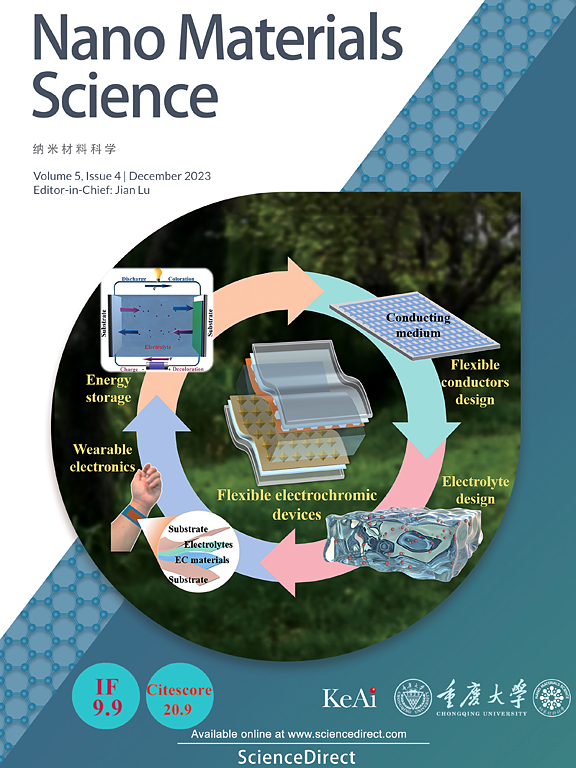Dimensionality engineering of flower-like bimetallic nanozyme with high peroxidase-activity for naked-eye and on-site detection of acrylamide in thermally processed foods
IF 17.9
2区 材料科学
Q1 Engineering
引用次数: 0
Abstract
Acrylamide (AA) is a neurotoxin and carcinogen that formed during the thermal food processing. Conventional quantification techniques are difficult to realize on-site detection of AA. Herein, a flower-like bimetallic FeCu nanozyme (FeCuzyme) sensor and portable platform were developed for naked-eye and on-site detection of AA. The FeCuzyme was successfully prepared and exhibited flower-like structure with 3D catalytic centers. Fe/Cu atoms were considered as active center and ligand frameworks were used as cofactor, resulting in collaborative substrate-binding features and remarkably peroxidase-like activity. During the catalytic process, the 3,3′,5,5′-tetrame-thylbenzidine (TMB) oxidation can be quenched by glutathione (GSH), and then restored after thiolene Michael addition reaction between GSH and AA. Given the “on–off–on” effect for TMB oxidation and high POD-like activity, FeCuzyme sensor exhibited a wide linear relationship from 0.50 to 18.00 μM (R2 = 0.9987) and high sensitivity (LOD = 0.2360 μM) with high stability. The practical application of FeCuzyme sensor was successfully validated by HPLC method. Furthermore, a FeCuzyme portable platform was designed with smartphone/laptop, and which can be used for naked-eye and on-site quantitative determination of AA in real food samples. This research provides a way for rational design of a novel nanozyme-based sensing platform for AA detection.
具有高过氧化物酶活性的花状双金属纳米酶的维度工程,用于肉眼和现场检测热加工食品中的丙烯酰胺
丙烯酰胺(AA)是热食品加工过程中形成的一种神经毒素和致癌物。常规的定量技术难以实现对AA的现场检测。本文研制了一种花状双金属FeCu纳米酶(FeCuzyme)传感器和便携式平台,用于裸眼和现场检测AA。成功制备了feecuzyme,并呈现出具有三维催化中心的花状结构。Fe/Cu原子被认为是活性中心,配体框架被用作辅因子,从而产生协同底物结合特征和显著的过氧化物酶样活性。在催化过程中,3,3 ',5,5 ' -四甲基联苯胺(TMB)的氧化可以被谷胱甘肽(GSH)猝灭,然后通过GSH与AA之间的噻吩Michael加成反应恢复。考虑到TMB氧化的“on-off-on”效应和高pod样活性,FeCuzyme传感器在0.50 ~ 18.00 μM范围内具有较宽的线性关系(R2 = 0.9987),灵敏度高(LOD = 0.2360 μM),稳定性好。HPLC法验证了该传感器的实际应用效果。结合智能手机/笔记本电脑设计了FeCuzyme便携式检测平台,可用于实际食品样品中AA的肉眼和现场定量检测。本研究为合理设计基于纳米酶的AA检测平台提供了途径。
本文章由计算机程序翻译,如有差异,请以英文原文为准。
求助全文
约1分钟内获得全文
求助全文
来源期刊

Nano Materials Science
Engineering-Mechanics of Materials
CiteScore
20.90
自引率
3.00%
发文量
294
审稿时长
9 weeks
期刊介绍:
Nano Materials Science (NMS) is an international and interdisciplinary, open access, scholarly journal. NMS publishes peer-reviewed original articles and reviews on nanoscale material science and nanometer devices, with topics encompassing preparation and processing; high-throughput characterization; material performance evaluation and application of material characteristics such as the microstructure and properties of one-dimensional, two-dimensional, and three-dimensional nanostructured and nanofunctional materials; design, preparation, and processing techniques; and performance evaluation technology and nanometer device applications.
 求助内容:
求助内容: 应助结果提醒方式:
应助结果提醒方式:


